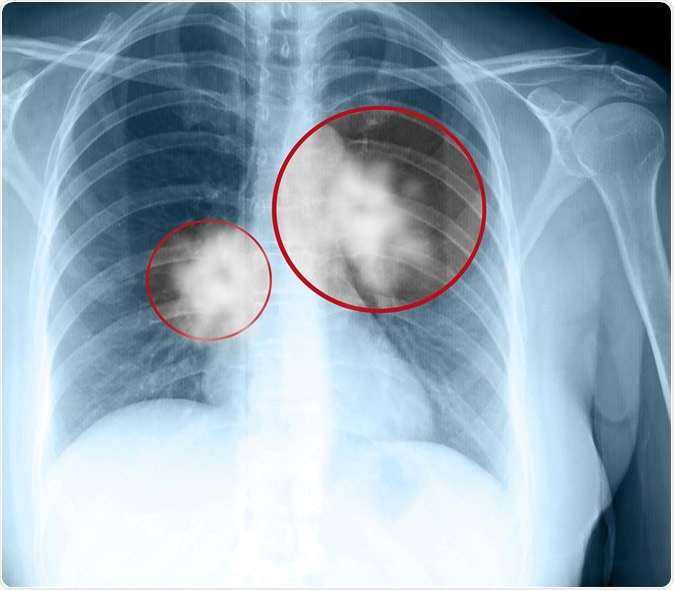Lung cancer is the number 1 killer among cancers, especially when it is of the non-small cell type. Among these, adenocarcinomas are the most common and aggressive type. These tumors also show a strong tendency to show dedifferentiation, or loss of the features that characterize a mature lung cell. This also makes it difficult to diagnose or treat this tumor since the cell of origin is frequently a mystery. Scientists are now able to explain that this is the result of cooperation between two separate mutations.
Previous research has shown that mutations in two cell pathways, the MAP kinase and the P13’-lipid signaling pathway, are primarily involved in about 75% of lung adenocarcinomas. These are normally regulators of cell proliferation, but when either of two cancer mutations occurs, they can overstimulate one of these pathways, causing a tumor to form. However, either of these mutations cannot cause cancer by themselves. The mechanism by which they cooperate to produce lung cancer was unclear.
A new study focuses on identifying the fundamental change in these cells that causes cancers to develop from the microscopic stage onwards to become large and aggressive.
As researcher Ed van Veen says, “"The pathways cooperate to drive the growth of malignant tumors, but we didn't know what molecular changes occurred as a result of this cooperation and how the lung cells lose their characteristics as cancer develops.”

Image Credit: Muratart / Shutterstock
How was the study done?
In many studies on mouse cells that have been genetically engineered to insert the cancer-promoting kinase BRAFV600E only in type 2 pneumocytes (AT2 pneumocytes). This mutation causes benign tumors with cells that strongly resemble the cells of origin, namely, the AT2 pneumocytes. The BRAF mutation thus always requires another event before malignant change occurs.
The current study used specially engineered mice that contained a conditional BRAFCAT gene along with bicistronic mRNA that expressed both the mutant BRAF and the tdTomato. A conditional allele is a gene which can be deleted in a specific tissue using a Cre recombinase enzyme which acts only in that tissue. Thus these mice express the BRAFV600E gene only in the AT2 pneumocytes, in combination with the tdTomato gene (which expresses a very bright red fluorescent protein as a marker) once the Cre enzyme is activated. This helps to detect varying patterns of BRAFV600E gene expression by the resulting fluorescence.
These mice were also engineered for another mutant gene called PIK3CAH1047R which is an activated form of the P13’-kinase-α, in the P13’ pathway. They were then studied for the levels of expression of various genes and proteins at different stages of tumor development.
What did the study show?
As expected the BRAF mutation produced a benign lung tumor. In isolation PIK3CAH1047R could not even initiate tumor formation. However, when both were present, the changes work together to start tumors which not only became malignant rapidly, but also lost their mature characteristics such as surfactant production, and showed rapid growth and spread.
At the same time, there was no increase in the production of the proteins that give the mature AT2 lung cells their identity, that is, factors like NKX2-1, FOXA1, or FOXA2 that regulate the transcription of hallmark AT2 pneumocyte proteins. This shows that the loss of AT2 markers is not related to the loss of these factors.
Conversely, the scientists suggest that the characteristics of mature AT2 lung cells are maintained by the function of another molecule called PGC1α within the tumor cell nucleus. When this PGC1α gene is silenced, tumors with BRAFV600E expression lose these characteristics. Tumors that show the BRAFV600E/PIK3CAH1047R phenotype show a consistent downregulation of PGC1α expression. This appears to occur via the P13K pathway.
PGC1α appears to act in cooperation with transcription factors NKX2-1 and FOXA1, activating promoter genes that increase the expression of AT2 products like surfactant, which is markedly reduced in its absence.
What do we learn?
In other words, the acquisition of malignant characteristics was due to the simultaneous expression of the two independent mutations, BRAFV600E and PIK3CAH1047R in the tumor cells. The novel mouse model used here promises to be very useful for further research into these separate mutations. The loss of mature lung cell characteristics is linked to the decrease in the levels of the PGC1α protein.
Researcher Martin McMahon says, “Taken together, our results shed light on the mechanisms by which pathways involved in lung tumor development also cooperate to influence the specialization of tumor cells.”
Journal reference:
Mutationally-activated PI3’-kinase-α promotes de-differentiation of lung tumors initiated by the BRAFV600E oncoprotein kinase. J Edward van Veen, Michael Scherzer, Julia Boshuizen, Mollee Chu, Annie Liu, Allison Landman, Shon Green, Christy Trejo, & Martin McMahon. eLife 2019;8:e43668. https://doi.org/10.7554/eLife.43668. https://elifesciences.org/articles/43668